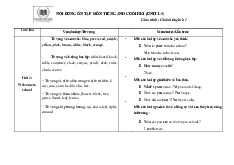







Preview text:
lOMoAR cPSD| 46836766
1. How to develop the influencer within you for the all levels of leadership?
Level 1: Position—Influence Based on Rights
Know your job description thoroughly.
Be aware of the history of the organization.
Relate the organization’s history to the people of the organization (in other words, be a team player). Accept responsibility.
Do your job with consistent excellence. Do more than expected.
Offer creative ideas for change and improvement. Level 2: Permission—
Influence Based on Relationship
Possess a genuine love for people.
Make those who work with you more successful.
See through other people’s eyes.
Love people more than procedures.
Do “win-win” or don’t do it.
Include others in your journey.
Deal wisely with difficult people.
Level 3: Production—Influence Based on Results
Initiate and accept responsibility for growth.
Develop and follow a statement of purpose.
Make your job description and energy an integral part of the statement of purpose.
Develop accountability for results, beginning with yourself.
Know and do the things that give a high return.
Communicate the strategy and vision of the organization.
Become a change agent, and understand timing. lOMoAR cPSD| 46836766
Make the difficult decisions that will make a difference. Level 4: People Development -
Influence Based on Reproduction
Realize that people are your most valuable asset.
Place a priority on developing people.
Be a model for others to follow.
Pour your leadership efforts into the top 20 percent of your people.
Expose key leaders to growth opportunities.
Be able to attract other winners/producers to the common goal.
Surround yourself with an inner core that complements your leadership. Level
5: Pinnacle - Influence Based on Respect
Your followers are loyal and sacrificial.
You have spent years mentoring and molding leaders.
You have become a statesman/consultant, and are sought out by others.
Your greatest joy comes from watching others grow and develop.
You transcend the organization.
2. Someone said that: Inspires and motivates others is the most important skill
for a successful leader. Provide your ideas on this statement? Provide an example?
The journey to success of an organization is not always smooth, even when the
members have mastered the vision and goals, because they are not always full of
initial will and excitement. . Therefore, maintaining inspiration and motivation for
employees is one of the most important tasks of leaders.
Inspires and motivates others is the most important skill for a successful leader
because Inspires and motivates skills help you spread the inspiration and motivation
to people in life and work. It must be a long process and requires a leader with
inspirational skills to convince each of his actions and words, and a leader's behavior
also contributes to creating the ability to communicate. inspiration for everyone. lOMoAR cPSD| 46836766
For example: Motivating employees can start from life. Taking your group out to
dinner is a good way to boost morale and boost team motivation. Planning your
team's dinner a week in advance and letting your employees look forward to it is an
effective way to motivate employees.
3. Someone said that: The quickest way to gain leadership is problem solving.
Provide your ideas on this statement? Provide an example?
Because through solving problems, we can gain the trust of the members. At the
same time, prove our ability. From there, it is easy to become a talented leader. From
a positive perspective, problems bring the leader benefits such as:
PROBLEMS INTRODUCE US TO OPPORTUNITIES
• Recognize a potential problem before it becomes a real problem.
• Get a clear picture of the problem
• Collect and analyze information
• Create a framework to exam problems and solutions
• Value shared problem solving
• Always come up with more than one solution
• Choose the best solution to solve the problem
• Actively look for opportunities and lessons in the problem
Example: In a Harvard Business Review study about the skills that influence a
leader’s success, problem solving ranked third out of 16.
When your group has two members who are in conflict over disagreements, you, the
leader, must be the one to stay calm. stand objectively to observe the problem. then,
analyze right and wrong in the conflict. then, give sincere advice, clearly analyze the
views to the members, so that everyone can understand and not be narcissistic.
4. Someone said that: the most important ingredient of leadership is integrity.
Provide your opinions on the above statement?
Integrity is choosing your thoughts and actions based on your values rather than
personal gain. If you lose your integrity, you’ll also lose your identity, your
sensitivity and your dignity. Integrity is honesty, modesty and security in all kinds
of weather. It should be any leader’s priority. Because Integrity builds trust, Integrity
has high influence value, Integrity facilitates high standard, Integrity results in a
solid reputation not just an image, Integrity means living it myself before leading
others, Integrity helps a leader be credible, not just clever, Integrity is a hard-won achievement lOMoAR cPSD| 46836766
5. Someone said that: The indispensable quality of leadership is vision. Provide
your opinions on the above statement?
Vision is very important for leaders and leadership activities. If leadership is
understood as establishing a vision; creating inspiration to the masses about that
vision and goal; Passion for dedication, action to realize the goal, the chosen path,
vision is the first essential element that creates a leader. The number one task of a
leader is to feel, perceive, and recognize the earliest and clearest trends, prospects,
and movement of the world around when all others have not yet seen it. or seen in a
very faint, discrete way. Therefore, the leadership vision is often the vision of a
minority, even of a single individual when it first appears and then it will be shared,
spread, disseminated and mastered to the majority.
Leadership is about having power, using power. Power is an intrinsic factor, the
foundation of leadership. A leader's power is not born purely from the title and
resources at hand. The right, timely, profound vision is the first basic element to
create the power of a leader. To properly recognize reality in order to improve and
develop it. Take a close look at your surroundings to discover your way.
Recognizing objective trends to determine goals, objectives, and paths. Look at the
situation to always be in the right direction. The result of all this recognition is the
power of the leader, who constantly has to make sure the work gets done in the right
direction, as opposed to the manager who has to make sure the work goes according
to plan. quality and effective.
6. Analyze 8 Steps of the decision making process? Provide an example? 1.
Defining the exact problem. Just as a disease cannot be cured without proper
diagnosis, so also no decision-making is possible unless the problem is properly diagnosed or known. 2.
Analyzing the problem. This is a systematic analysis of the available data.
Sound decisions are based on proper collection, classification and analysis of facts and figures. 3.
Searching for alternative solutions. A problem can be solved in several ways.
However, all the ways cannot be equally satisfying. Further, if there is only one way
of solving a problem, no question of decision-making arises. 4.
Evaluating the alternatives. Evaluating the various identified alternatives to
find out how each alternative may contribute towards the objectives supposed to be
achieved by implementing the decision. lOMoAR cPSD| 46836766 5.
Selecting the best alternative. A comparison is made among the likely
outcomes of various alternatives and the best one is chosen. 6.
Implementation of the decision. Proper and effective communication of
decisions to the subordinates. Acceptance of decision by the subordinates is important. 7.
Following-up the decision. A follow up system ensures the achievement of
the objectives. It is exercised through control. Simply stated it is concerned with the
process of checking the proper implementation of decision. 8.
Monitoring and feedback. Feedback provides the means of determining the
effectiveness of the implemented decision. The monitoring system should be such
that the manager can go and look for himself for first hand information which is
always better than the written reports or other second-hand sources. FOR EXAMPLE:
Decision-Making In Human Resources
Imagine you are the CEO of an e-commerce start-up. Your work is expanding and
you need to hire the right resources to help you realize the vision of creating a leading online retail platform.
You would need to hire people who are experienced and adept in their fields such as
software development, marketing, operations, procurement, and logistics.
Since the business is an online start-up, you won’t need to hire employees who work
on the premises exclusively. You can also get talented location-independent workers
capable of delivering the required technical support and services online.
By ensuring an optimal mix of on-site and remote workers, you can easily carry out
the functions in a cost-effective way. Emails and chat communications as well as
video interactions can keep the team spirit going. This will also give you the
flexibility of hiring talent that might be scattered over different geographic locations
and can come together digitally to create path-breaking solutions.
7. Analyze the advantages and disadvantages of group decision making compare
to individual decision making? ADVANGTAGE 1 . More information :
A group is better equipped as far as information is concerned. lOMoAR cPSD| 46836766
An individual cannot have all the information that is available to a group as it
consists of several individuals. 2 . Diversity of views :
A group always has the advantage of varied views. This is because a group always
has more than one member, and since every member is unique, there is bound to be
a variety in their views also. This is also the reason why there are varied approaches
to solving a problem. As group decisions tend to cover a greater area, they provide
a better insight for decision-making. 3. Greater acceptability :
The views expressed by a group have more acceptance than those from an individual.
This is because the decisions are not imposed, but are part of a larger consensus
(general agreement). A group decision is automatically assumed to be more
democratic, and the decision of an individual can be perceived as being autocratic (dictatorial). 4. Expert opinions :
There may be some group decisions that require expert opinion. The group can either
include experts or can call them from outside to form a separate group to take a
decision on a particular issue. 5. Degree of involvement :
The members of a group feel involved with a given problem. This minimizes their
resistance. It strengthens an organisation and facilitates decision-making.
6. Encourages people’s participation :
A group usually provides a platform for people to present their ideas. Group
dynamics is more likely to draw out participation from people who may otherwise
be hesitant to talk or interact. It encourages people to take an initiative as they feel
part of the decision-making process.
Usually there is no individual onus (burden) in the event of failure, which makes it
easier for people to come up with suggestions and solutions to problems. DISADVANTAGES: 1 .Time-consuming :
A group involves several individuals. Getting them organised, planning and
coordinating their meetings, defining and explaining to them the purpose of a lOMoAR cPSD| 46836766
meeting and the goals, and finally reaching a solution or arriving at a decision can
be quite cumbersome. Making decisions in a group can, thus, be time-consuming.
The time loss involved in group dynamics cannot be ignored. 2. Lack of onus :
It is difficult to fix responsibility in a group. In an organisation, it is often essential
to fix responsibility before a problem can be solved. It is difficult to do so if anything
goes wrong with a decision made by a group. 3. Individual domination :
Quite often, discussions in a group are dominated by a few members. Although a
group discussion means a collective discussion, some people usually manage to
usurp (draw to them) a position of informal leadership owing to their personality or style of participation. 4. Compromise decisions :
The need to arrive at a group decision sometimes results in a compromise. The
solution offered is not essentially the best. It is, instead, a compromise acceptable as
a mid-point to all concerned. There are different demands and social pressures, and
members may agree to a proposal without really evaluating it. Such support may not be wholehearted. 5. Expensive :
Group decision-making is quite expensive in terms of time, money, energy and man-
hours. There is also a theory which says that the larger a group gets, the less is the
individual contribution from each member. 6. Groupism :
The very word has negative connotations. Some members of a group may start
harbouring a feeling that they are different from the others. This actually leads to
informal groups within the larger formal group, which may generate negative
sentiments towards other groups or people outside the group.
8. Analyze techniques of decision making? Provide an example?
Multiple Criteria Decision Analysis:
Multi-Criteria Decision Analysis (MCDA) is a general framework for supporting complex
decision-making situations with multiple and often con 昀氀 icting objectives. lOMoAR cPSD| 46836766
The decision making tree: ng techniques, probably
due to its inherent ease in visually communicating a choice, or set of choices, along with
their associated uncertainties and outcomes.
Cost/Benefit analysis - This is limited to 昀椀 nancial decisions or can provide the data
for evaluation of 昀椀 nancial criteria in other decision making techniques.
Net Present Value (NPV) and Present Value (PV) are often used for capital
budgeting and investment decisions. NPV is sometimes considered a single criteria decision technique.
Linear Programming(LP) - Generally used to optimize limited resources, linear
programming is a mathematical technique where requirements are represented by linear
equations. Useful problems in operations research can be addressed using this technique.
Example: The decision making tree




